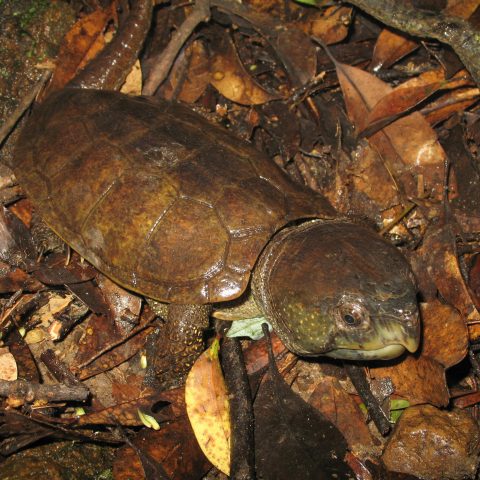Conservation Actions
Batagur trivittata is included in CITES Appendix II, allowing international commercial trade in the species provided such trade is not detrimental to the species, and subject to national trade legislation.; the species is also protected by national legislation. In situ nest protection efforts have been underway at the Chindwin nesting site since 2005. There are about 900 animals in four different assurance colonies in Myanmar; and an assurance colony at Singapore Zoo (K. Platt pers. comm. 2018). The Mandalay assurance colony is currently breeding; other assurance colonies are not yet reproducing (K. Platt pers. comm 2018). Four captive females (including one F1 female) have reproduced in captivity, representing an independent assurance colony. Hatchlings are head-started in the safety of a local facility. The first release took place in 2012 (ten males); in 2015, 30 males and 30 females were released; in March 2018 15 males and 15 females were released with 10 more males to be released in November 2018 (K. Platt pers. comm 2018).Location Information
Historically, Batagur trivittata occurred throughout the Ayeyarwady-Chindwin system, as well as the Sittaung and lower Thanlwin (Salween) Rivers of Myanmar. Its present occurrence is restricted to a limited stretch of the upper Chindwin, with the farthest records some 80 km apart on the river, although anecdotal observations suggest incidental occurrence over a 200 km stretch (K. Platt, unpubl. data). It occurs at elevations of about 150 to 200 m above seal level.Geographic Range
Extant
Myanmar
Population Information
The Chindwin subpopulation of Batagur trivittata is estimated to comprise fewer than 10 adult females at the time of assessment. Persistence of the species was recorded for the Doke-tha-wady (tributary of the middle Ayeyarwady) in 2004, but the river section concerned has been dammed since then and follow-up surveys have failed to locate animals and there is no anecdotal indications of their continuing survival. A few adults are maintained in captivity in Mandalay. This represents a major total population reduction compared to the last available data from 1900 and 1935, when the species was still widespread and relatively abundant throughout its original range, with nesting aggregations of dozens to thousands of animals having been reported (Maxwell 1911, Theobald 1968, Smith 1931).Threats
Batagur trivittata has been extensively exploited through intensive collection of its eggs from its well-known, predictable nesting sites, and through direct take of adults and juveniles for subsistence consumption and export into the live turtle trade to supply demand from East Asia. In addition, its last remaining cluster of nesting sites in the upper Chindwin is at severe risk from the impacts of gold dredging and plans for a hydroelectric reservoir which, if constructed, would flood the remaining range and nest sites of the species (K. Platt pers. comm. 2018). The species continues to be impacted by habitat degradation, principally this is increased turbidity of water resulting from sedimentation flows from upstream deforestation (for instance in Nagaland, India) (K. Platt pers. comm. 2018). An additional impact is through illegal fishing practices within the species range, including poison fishing, dynamite fishing etc. (K. Platt pers. comm. 2018). Males move extensively around the river system and are impacted/lost more readily, this can reduce the fertility of the number of eggs laid by the females within the protected areas (K. Platt pers. comm. 2018).Partners
IUCN Red List Account Link
Please click here to see the species' IUCN Red List Account page.Photo Credits
Wildlife Reserves Singapore






